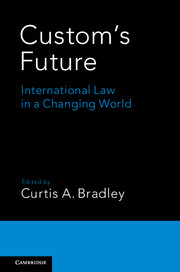Book contents
- Frontmatter
- Dedication
- Contents
- Notes on Contributors
- Introduction: Custom's Future
- 1 Custom's Past
- 2 Customary International Law Adjudication as Common Law Adjudication
- 3 Customary International Law as a Dynamic Process
- 4 Custom, Jus Cogens, and Human Rights
- 5 Customary International Law: How Do Courts Do It?
- 6 Custom's Method and Process: Lessons from Humanitarian Law
- 7 The Growing Obsolescence of Customary International Law
- 8 The Strange Vitality of Custom in the International Protection of Contracts, Property, and Commerce
- 9 The Decline of Customary International Law as a Source of International Criminal Law
- 10 Customary International Law and Public Goods
- 11 Reinvigorating Customary International Law
- 12 The Evolution of Codification: A Principal-Agent Theory of the International Law Commission's Influence
- 13 Custom and Informal International Lawmaking
- 14 Custom's Bright Future: The Continuing Importance of Customary International Law
- Bibliography
- Index
6 - Custom's Method and Process: Lessons from Humanitarian Law
Published online by Cambridge University Press: 05 February 2016
- Frontmatter
- Dedication
- Contents
- Notes on Contributors
- Introduction: Custom's Future
- 1 Custom's Past
- 2 Customary International Law Adjudication as Common Law Adjudication
- 3 Customary International Law as a Dynamic Process
- 4 Custom, Jus Cogens, and Human Rights
- 5 Customary International Law: How Do Courts Do It?
- 6 Custom's Method and Process: Lessons from Humanitarian Law
- 7 The Growing Obsolescence of Customary International Law
- 8 The Strange Vitality of Custom in the International Protection of Contracts, Property, and Commerce
- 9 The Decline of Customary International Law as a Source of International Criminal Law
- 10 Customary International Law and Public Goods
- 11 Reinvigorating Customary International Law
- 12 The Evolution of Codification: A Principal-Agent Theory of the International Law Commission's Influence
- 13 Custom and Informal International Lawmaking
- 14 Custom's Bright Future: The Continuing Importance of Customary International Law
- Bibliography
- Index
Summary
A central question in the literature on customary international law (CIL) goes to method: what is the proper method for “finding” CIL – that is, for determining that particular norms qualify as CIL? The traditional method is to identify a widespread state practice, plus evidence that states believe that the practice reflects the law (opinio juris). That method has long been criticized as incoherent, unworkable, and out of touch with modern sensibilities. Thus, much of the CIL literature addresses its perceived problems. The principal goals of this literature are to help resolve whether norms that are claimed to be CIL are really CIL, and thus to reduce the volatility and susceptibility to abuse in CIL.
I argue in this chapter that the method for finding CIL might be so elusive because the question itself is misconceived. The question of how to find CIL presupposes that finding CIL is an objective exercise and somehow removed from the process for making CIL. This process is notoriously undisciplined and politically charged. To make CIL, disparate actors advance and respond to one another's legal claims, as they pursue their own interests. The methodological question assumes that CIL finding is distinct – that actors who find CIL do not advance their own agendas but rather assess the evidence objectively and thus that their decisions help settle CIL and weed out invalid claims. I use the recent rise of CIL in international humanitarian law to show that these assumptions are flawed. CIL finding is deeply entangled with CIL making. The two exercises operate in much the same way and through the same process, so they share similar limitations.
My argument has two practical implications. First, nonstate actors who are charged with finding CIL can be extremely influential in making CIL. Some of these actors play a much larger role in the formation of CIL than the literature now recognizes. Second, no particular method for finding CIL is capable of disciplining global actors or imposing order on CIL, because the process for making CIL is so heavily undisciplined and disordered.
THE QUESTION OF METHOD
The frustrations with finding CIL stem directly from the nature of the CIL process. This process is chaotic, unstructured, and politically charged. The participants make and respond to competing claims on the law as they advance their own agendas.
Information
- Type
- Chapter
- Information
- Custom's FutureInternational Law in a Changing World, pp. 148 - 171Publisher: Cambridge University PressPrint publication year: 2016
Accessibility standard: Unknown
Why this information is here
This section outlines the accessibility features of this content - including support for screen readers, full keyboard navigation and high-contrast display options. This may not be relevant for you.Accessibility Information
- 1
- Cited by
